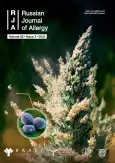Spectrum of sensitization to aeroallergens as one of the risk factors for uncontrolled severe asthma
- Authors: Kozlova Y.I.1, Vasiliev N.Y.1, Frolova E.V.1, Uchevatkina A.E.1, Filippova L.V.1, Vasilyeva N.V.1
-
Affiliations:
- North-Western State Medical University named after I.I. Mechnikov
- Issue: Vol 20, No 3 (2023)
- Pages: 275-286
- Section: Original studies
- URL: https://journals.rcsi.science/raj/article/view/251321
- DOI: https://doi.org/10.36691/RJA15043
- ID: 251321
Cite item
Full Text
Abstract
BACKGROUND: Asthma is considered one of the urgent medical and social problems of the XXI century. In recent years, not only an increase in the incidence, but also an increase in the prevalence of severe forms of asthma has been noted in all countries of the world. The effect of the sensitization spectrum on the severity and level of asthma control has not been studied enough.
AIM: Evaluate the importance of sensitization spectrum to aeroallergens in severe asthma patients as indicators for disease exacerbation risk.
MATERIALS AND METHODS: Single-center cross-sectional study at North-Western State Medical University n.a. I.I. Mechnikov. Examined 93 severe asthma patients. Analysis covered demographic traits, comorbidities, hereditary history, living conditions, exacerbations, past-year hospitalizations, medications, spirometry, and specific IgE presence for 10 aeroallergens.
RESULTS: Aspergillus fumigatus specific IgE notably impacted asthma control. Disease exacerbation risk was 8.4 times higher with A. fumigatus sensitization. Multivariate logistic regression revealed higher risk with A. fumigatus sensitization (4.79×), fixed obstruction (6.2×), systemic steroids use (5.85×), indoor mold exposure (4.45×), and familial asthma history (2.53×).
CONCLUSION: A. fumigatus sensitization significantly influences asthma course and control, worsening prognosis. Targeted examination of patients measuring sIgE levels for common aeroallergens is necessary to identify control obstacles. The results of the study were previously reported at the All-Russian Congress on Medical Microbiology, Clinical Mycology and Immunology and published in the form of abstracts in the journal “Problems in medical mycology”, 2022, Vol. 24, No 2.
Full Text
##article.viewOnOriginalSite##About the authors
Yana I. Kozlova
North-Western State Medical University named after I.I. Mechnikov
Author for correspondence.
Email: kozlova510@mail.ru
ORCID iD: 0000-0002-4602-2438
SPIN-code: 5842-6039
MD, Dr. Sci. (Med.), Associate Professor
Russian Federation, Saint PetersburgNikolay Y. Vasiliev
North-Western State Medical University named after I.I. Mechnikov
Email: wwjd2000@mail.ru
ORCID iD: 0000-0003-0793-2831
SPIN-code: 2150-3380
ResearcherId: ABX-3797-2022
Russian Federation, Saint Petersburg
Ekaterina V. Frolova
North-Western State Medical University named after I.I. Mechnikov
Email: ekaterina.frolova@szgmu.ru
ORCID iD: 0000-0002-7696-2236
SPIN-code: 9904-8776
MD, Cand. Sci. (Med.)
Russian Federation, Saint PetersburgAlexandra E. Uchevatkina
North-Western State Medical University named after I.I. Mechnikov
Email: a.uchevatkina@szgmu.ru
ORCID iD: 0000-0001-6688-7781
SPIN-code: 3001-4022
MD, Cand. Sci. (Med.)
Russian Federation, Saint PetersburgLarisa V. Filippova
North-Western State Medical University named after I.I. Mechnikov
Email: larisa.filippova@szgmu.ru
ORCID iD: 0000-0003-4167-7440
SPIN-code: 6810-0871
MD, Cand. Sci. (Med.)
Russian Federation, Saint PetersburgNatalya V. Vasilyeva
North-Western State Medical University named after I.I. Mechnikov
Email: mycobiota@szgmu.ru
ORCID iD: 0000-0003-3693-5468
SPIN-code: 3829-4370
Dr. Sci. (Biol.), Professor
Russian Federation, Saint PetersburgReferences
- Chung KF, Wenzel SE, Brozek JL, et al. International ERS/ATS guidelines on definition, evaluation and treatment of severe asthma. Eur Res J. 2014;43(2):343–373. doi: 10.1183/09031936.00202013
- Nenasheva NM. Atopic asthma: the role of allergen-specific immunotherapy. Russ J Allergy. 2015;12(6):54–67. (In Russ). doi: 10.36691/RJA391
- Macharadze DSh. Some features of the prevalence of respiratory allergies in the south of Russia. Russ J Allergy. 2019;16(1):23–29. (In Russ). doi: 10.36691/RJA17
- Xie ZJ, Guan K, Yin J. Advances in the clinical and mechanism research of pollen induced seasonal allergic asthma. Am J Clin Exp Immunol. 2019;8(1):1–8.
- Denning DW, O’Driscoll BR, Hogaboam CM, et al. The link between fungi and severe asthma: A summary of the evidence. Eur Respir J. 2006;27(3):615–626. doi: 10.1183/09031936.06.00074705
- Demoly P, Liu AH, Rodriguez DR, et al. A pragmatic primary practice approach to using specific IgE in allergy testing in asthma diagnosis, management, and referral. J Asthma Allergy. 2022;15:1069–1080. doi: 10.2147/JAA.S362588
- Woolnough KF, Richardson M, Newby C, et al. The relationship between biomarkers of fungal allergy and lung damage in asthma. Clin Exp Allergy. 2017;47(1):48–56. doi: 10.1111/cea.12848
- Medrek SK, Kao CC, Yang DH, et al. Fungal sensitization is associated with increased risk of life-threatening asthma. J Allergy Clin Immunol Pract. 2017;5(4):1025–1031.e2. doi: 10.1016/j.jaip.2016.11.015
- Maurya V, Gugnani HC, Sarma PU, et al. Sensitization to Aspergillus antigens and occurrence of allergic bronchopulmonary aspergillosis in patients with asthma. Chest. 2005;127(4):1252–1259. doi: 10.1378/chest.127.4.1252
- Goh KJ, Yii AC, Lapperre TS, et al. Sensitization to Aspergillus species is associated with frequent exacerbations in severe asthma. J Asthma Allergy. 2017;10:131–140. doi: 10.2147/JAA.S130459
- Sio YY, Pang SL, Say YH, et al. Sensitization to airborne fungal allergens associates with asthma and allergic rhinitis presentation and severity in the singaporean/malaysian population. Mycopathologia. 2021;186(5):583–588. doi: 10.1007/s11046-021-00532-6
- Liu A, Luskin A, Brown R, et al. The practical application of allergic trigger management to improve asthma outcomes: Step 1: Identify patients with allergic components of asthma. Pediatrics News. [Internet]. 2018;S5–S13. Available from: https://cdn.mdedge.com/files/s3fs-public/Document/September-2018/pn_thermofisher0918_low_res.pdf. Accessed: 10.07.2023.
- Ryan D, Heatley H, Heaney LG, et al. Potential severe asthma hidden in UK primary care. J Allergy Clin Immunol Pract. 2020;9(4)1612–1623. doi: 10.1016/j.jaip.2020.11.053
- Mathioudakis AG, Tsilochristou O, Adcock IM, et al. ERS/EAACI statement on adherence to international adult asthma guidelines. Eur Respir Rev. 2021;30(161):161. doi: 10.1183/16000617.0132-2021
- Larenas-Linnemann D, Baxi S, Phipatanakul W. Environmental Allergens Workgroup. Clinical evaluation and management of patients with suspected fungus sensitivity. J Allergy Clin Immunol Pract. 2016;4(3):405–414. doi: 10.1016/j.jaip.2015.10.015
- Black PN, Udy AA, Brodie SM. Sensitivity to fungal allergens is a risk factor for life-threatening asthma. Allergy. 2000;55(5):501–504. doi: 10.1034/j.1398-9995.2000.00293.x
- Vicencio AG, Santiago MT, Tsirilakis K, et al. Fungal sensitization in childhood persistent asthma is associated with disease severity. Pediatr Pulmonol. 2014;49(1):8–14. doi: 10.1002/ppul.22779
Supplementary files









